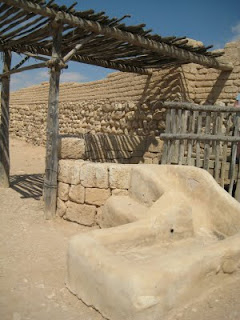
Looking at the lower city of Tel Arad
The south in Israel is a dynamic region that can easily be perceived as holding no life at all. Through history people inhabiting the southern region must have possessed a certain innovation and willingness to live.
The Negev region has one of the east-west trade routes running through it, making the region important despite the climate barriers. Sites located along this path were meant to fortify the area.
Tel Sheva is a large Tel located in the western Negev and it served various administrative purposes for Judah. The site was important not only for fortification purposes, but also for military reasons.
Archeologists at Beer Sheva have uncovered some interesting finds. One is a typical four-room house along the perimeter of the site, and is the same as what I was working in at my site. This architecture is typical for Israel; three rooms go long way and are located next to each other, and the fourth room is at the back and is the length of the three other rooms. This is where animals were stored at night and during the winter, and the families would sleep in a room above on the second floor. This is important because this architecture is found across Israel (I’m excavating inside one at my site even).

The four room house
Interestingly, archeologists also found a dismantled horned altar, something associated with Jewish worship. What makes this altar different from others is the cut stone used to form the altar, something forbidden in the religion. The altar was initially found because archeologists recognized the shape of a corner horn, and then found the other scattered stones in secondary use. This would suggest the altar was dismantled, perhaps during the religious reforms of King Hezekiah or Josiah.

A replica of the altar (the real finds are in the Israel Museum, which I did see!)
Tel Arad is another important site for this trading route. Located east of Beer Sheva in the east Negev region, this Tel is located in the hills, providing the site with a fantastic view in the southern direction. This means those living at this site had a view of Moab and Edom, two regions not always friendly with the Israelites. Its location also made it a crucial stop for those traveling on the trading route.
Interestingly, Tel Arad has two parts to it. There is the Tel on the hill, dating from Israelite occupation and later, and there is also a lower city dating from the Bronze Age. In the harsh south of Israel, water is a crucial commodity, and ways to get the water are important to the livelihood of the population. In this lower Bronze Age city, the population collected water from the rainfall by designing their city with the well at the low point, and having the streets slope downward. This allowed runoff water to collect in the well for later use. This innovation is extremely interesting, and shows the ingenuity of the populations living in this region.

Lower Bronze Age City
Also interesting to Tel Arad is a holy site discovered there. A room dubbed the “Holy of Holies” was found with two stones shaped a bit like gravestones. The curious part of this site is that there are two stones there at all; the Israelites worshiped only one God. It has been suggested the second stone may represent God’s partner, an idea accepted in the fringe areas of Israel, areas with more lax views on religion and with Canaanite and other worldviews intermixed within the religion.

Holy of Holies at Tel Arad
Now compare the two findings at both site out of character for the Jewish religion. Tel Arad and Tel Sheva may represent two places fringe ideas are incorporated in important defensive locations. But this is interpretation, and more importantly only one interpretation of the sites.
Enjoy my pictures and as always happy history!

Tel Sheva from above looking down

The well at Tel Sheva; it is very deep (I remember 60 meters maybe) and when we threw stones down it took over 10 seconds to hear a sound.

The water system at Tel Sheva.

Gate into Tel Arad

Bronze Age well that collected water at Tel Arad

The Altar at Tel Arad. Notice these stones are not cut like at Tel Sheva.










